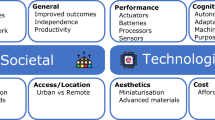Abstract
Performance of robots in human robot teams has always been a topic of interest for many researchers in human robot interaction community. Traditionally adopted neglect tolerance model for performance measurements assume ideal conditions in which the operator switches control between robots sequentially based on acceptable performance level for each robot ignoring any false alarms due to erroneous interactions. In this paper, we present the false alarm demand, a new metric for measuring effects of false alarms on human robot team performance and extend the neglect tolerance model to situations in which false positives and false negatives are prevalent. Experiments were performed with real and virtual humanoid soccer robots across tele-operated, and point to point modes of autonomy. Measured false alarm demand and robot performances were largely consistent with the proposed extended neglect tolerance model predictions for real and virtual experiments for both autonomy modes. Experiments also showed that extended neglect tolerance model offered better estimation of robot performances as compared to the traditionally adopted neglect tolerance model for situations wherein false alarms are prevalent.
Similar content being viewed by others
References
Metev SM, Veiko VP (2006) Task structure and user attributes as elements of human-robot interaction design. In: Proceedings of IEEE international symposium on robot and human interactive communication
Wang J, Wang H, Lewis L, Scerri P, Velagapudi P, Katia S (2008) Experiments in coordination demand for multirobot systems. In: Proceedings of IEEE international conference on distributed human-machine systems
Goodrich MA, Schultz AC (2007) Human-robot interaction: a survey. In: Foundations and trends in human-computer interaction, pp 203–275
Drury JL, Scholtz J, Yanco HA (2003) Awareness in human-robot interactions. In: Proceedings of the IEEE conference on systems, man and cybernetics
Goodrich MA, Olsen DR (2003) Seven principles of efficient interaction. In: Proceedings of IEEE international conference on systems, man, and cybernetics, pp 3943–3948
Bartneck C, Kulic D, Croft E, Zoghbi S (2008) Measurement instruments for the anthropomorphism, animacy, likeability, perceived intelligence, and perceived safety of robots. Int J Soc Robot 1(1)
Crandall JW, Goodrich MA (2002) Characterizing efficiency of human-robot interaction: a case study of shared-control teleoperation. In: Proceedings of IEEE/RSJ international conference on intelligent robots and systems
Crandall JW, Goodrich MA (2001) Experiments in adjustable autonomy. In: Proceedings of IEEE international conference on systems, man, and cybernetics
Dufourd D, Dalgalarrondo A (2006) Integrating human/robot interaction into robot control architectures for defense application. In: Proceedings of first national workshop on control architectures for robots
Stein M (1994) Behavior-based control for time-delayed teleoperation. Dissertation, University of Pennsylvania
Kheddar A, Atlani D, Iles A, Blazevic P (1996) New trends in legged robots teleoperation. In: Proceedings of IEEE international symposium on robot and human interactive communication
Rofer T, Lankenau A (1999) Ensuring safe obstacle avoidance in a shared-control system. In: Proceedings of seventh international conference on emergent technologies and factory automation
Ong KW, Seet G, Sim SK (2008) An implementation of seamless human-robot interaction for telerobotics. Int J Adv Robot Syst 5(2)
Paul M, Peter A (1994) Shared autonomy in a robot hand teleoperation system. In: Proceedings of the international conference on intelligent robotics systems
Crandall JW, Goodrich MA, Olsen DR, Nielsen CW (2005) Validating human-robot interaction schemes in multi-tasking environments. IEEE Trans Syst Man Cybern Part A 35(4):438–449
Goodrich MA, Crandall JW, Stimpson JL (2003) Neglect tolerant teaming: issues and dilemmas. In: Proceedings of the AAAI spring symposium on human interaction with autonomous systems in complex environments
Crandall JW, Cummings ML (2007) Identifying predictive metrics for supervisory control of multiple robots. IEEE Trans Robot 23(5)
Crandall JW, Nielsen CW, Goodrich MA (2003) Towards predicting robot team performance. In: 2003 IEEE international conference on systems, man, and cybernetics
Goodrich MA, Crandall JW, Stimpson JR (2003) Neglect tolerant teaming: issues and dilemmas. In: Proceedings of AAAI spring symposium on human interaction with autonomous systems in complex environments
Steinfeld, Fong T, Kaber D, Lewis M, Scholtz J, Schultz A, Goodrich M (2006) Common metrics for human-robot interaction. In: Proceedings of the human-robot interaction conference
Olsen DR, Wood SB (2004) Fan-out: measuring human control of multiple robots. In: Proceedings of the SIGCHI conference on Human factors in computing systems
Zhou C, Yue PK (2004) Robo-Erectus: a low cost autonomous humanoid soccer robot. Adv Robot 18(7):717–720
Mohan RE, Acosta Calderon CA, Zhou C, Yue PK, Hu L (2008) Modelling human-humanoid robot interaction in soccer robotics domain using NGOMSL. In: Proceedings of 17th IEEE international symposium on robot and human interactive communication
Mohan RE, Acosta Calderon CA, Zhou C, Yue PK, Hu L, Iniya B (2008) An embedded vision system for soccer playing humanoid robot: Robo-Erectus Junior. In: Proceedings of IEEE international conference on signal processing, communications and networking
Acosta Calderon CA, Mohan RE, Zhou C, Yue PK, Hu L (2007) Integration of robust embedded vision and control for a soccer playing humanoid robot. In: The 4th international conference on computational intelligence, robotics and autonomous systems, Palmerston North, New Zealand
Acosta Calderon CA, Zhou C, Yue PK, Wong M, Mohan RE (2007) Robo-Erectus Junior: a kid size soccer-playing humanoid robot. In: RoboCup 2007 team description paper in symposium
Acosta Calderon CA, Zhou C, Yue PK, Wong M, Mohan RE (2007) A distributed embedded control architecture for humanoid soccer robots. In: Proceedings of International conference on climbing and walking robots and the supporting technologies for mobile machines, pp 487–496
Acosta Calderon CA, Mohan RE, Zhou C (2007) A humanoid robotic simulator with application to robocup. In: Proceedings of IEEE Latin America robotic simposium/congreso mexicano de robotica (LARS), Mexico
Smith R (2008) Open dynamics engine. http://www.ode.org
Crandall JW (2003) Towards developing effective human-robot systems. MS thesis, Brigham Young University
Author information
Authors and Affiliations
Corresponding author
Rights and permissions
About this article
Cite this article
Elara, M.R., Wijesoma, W.S., Acosta Calderon, C.A. et al. Experimenting False Alarm Demand for Human Robot Interactions in Humanoid Soccer Robots. Int J of Soc Robotics 1, 171–180 (2009). https://doi.org/10.1007/s12369-009-0017-3
Received:
Accepted:
Published:
Issue Date:
DOI: https://doi.org/10.1007/s12369-009-0017-3




